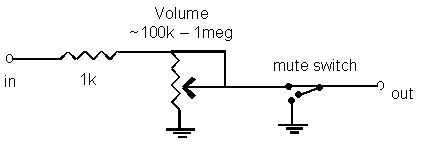Here is a basic schematic for an excellent passive ‘preamp’:

Notes: You can insert a source selector between the input and the 1k resistor. Speaking about the 1k resistor – it should be a Caddock or Vishay. Weak link theory applies. The rest of the parts can even be sourced from Radio Shack and the result will still be better than most things you can buy with a power cord. The mute switch is a double pole. As an experiment and to test the concept, you can build this with just the pot and resistor, and a couple of RCA jacks. 2x for stereo. Maybe $10.
Legal stuff: No warranties express or implied. I am not responsible for damages to you, your system, or the building it’s in, or loss of use of any of that stuff.
Compared to several preamps under $5k, this is a winner! And it’s always ‘warmed up’ and ready to go. The breakeven point seems to be about $4k. You have to spend that much or more on an active preamp to equal the sonic abilities of a good passive preamp.
What’s the catch? The power amplifier should have an input impedance of 50k ohms or greater. If you’re wondering what a “k” is, click on “Home” on your browser now.
A real user experience building a passive preamp (thanks to Herman V.), with minor edits:
I didn’t want to spend huge amounts of time on chassis work and appearance, so I purchased a “Mod Squad” passive on the Internet used for $350. The interior was well thought out with obviously a great deal of care used to run bare silver wire everywhere. It didn’t sound all that great; somewhat better than a Conrad Johnson PV12, mainly in extension not so much in clarity.
I thought the Alps volume and balance pots were the most likely culprit and since I had decided long before to build my own switched attenuator I ordered the Vishay S102 resistors and a Shallco silver contact switch and mounted them into the same box (almost fit, I had to cut a clearance for the Shallco).
The sound was quite improved but still a long way from stellar. The next most likely problem I thought would be the silver wire or possibly the gold plated RCA jacks. So I bought Cardas 5 nines silver (continuous cast and annealed) and Cardas one step down from the top jacks. Now there was some additional improvement but still a hardness that was out of place. I removed the input selector and tape loop switches from the signal path – wow, that was it! The improvement was immediate and substantial.
Finally the expected results from a passive pre; very open, grainless sound with full frequency extension and great dynamics. Many people have said passives lack dynamics I am loath to understand how this is possible, mine certainly doesn’t suffer from this.
So my point is that even something as simple as a passive will only accomplish great results with great care and the choice of great components. (I think your example design with a 1 meg pot will suffer from cable capacitance and that the sound will change with volume setting, most preamps can easily drive far lower resistance why not default to a 100K or even a 10K pot?)
Good luck with your own design.
Feedback?? I am especially interested in hearing about cases where a passive preamp did not perform up to your expectations.
